Analysis of the impact of exchange rate and interest rate on stock return in vietnam stock market
By using the multiple regression models we find out the impact of exchange rate
and interest rate on stock return of 3 companies which present for 3 difference lines:
technology - FPT Joint Stock Company (FPT), Construction trades Kinh Bac City
Development Share Holding Corporation (KBC) and food industry - Viet Nam Dairy Products
Joint Stock Company (VNM).
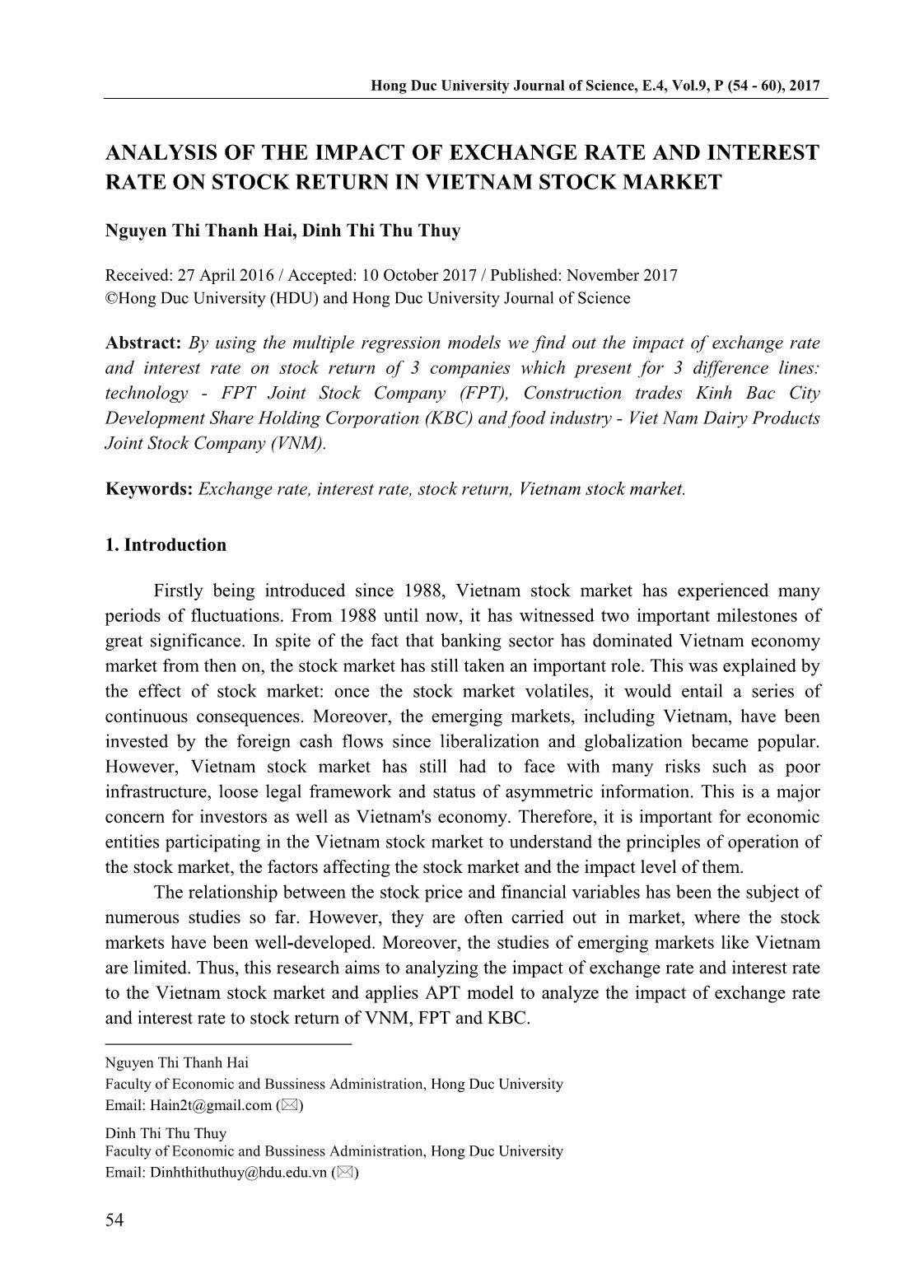
Trang 1
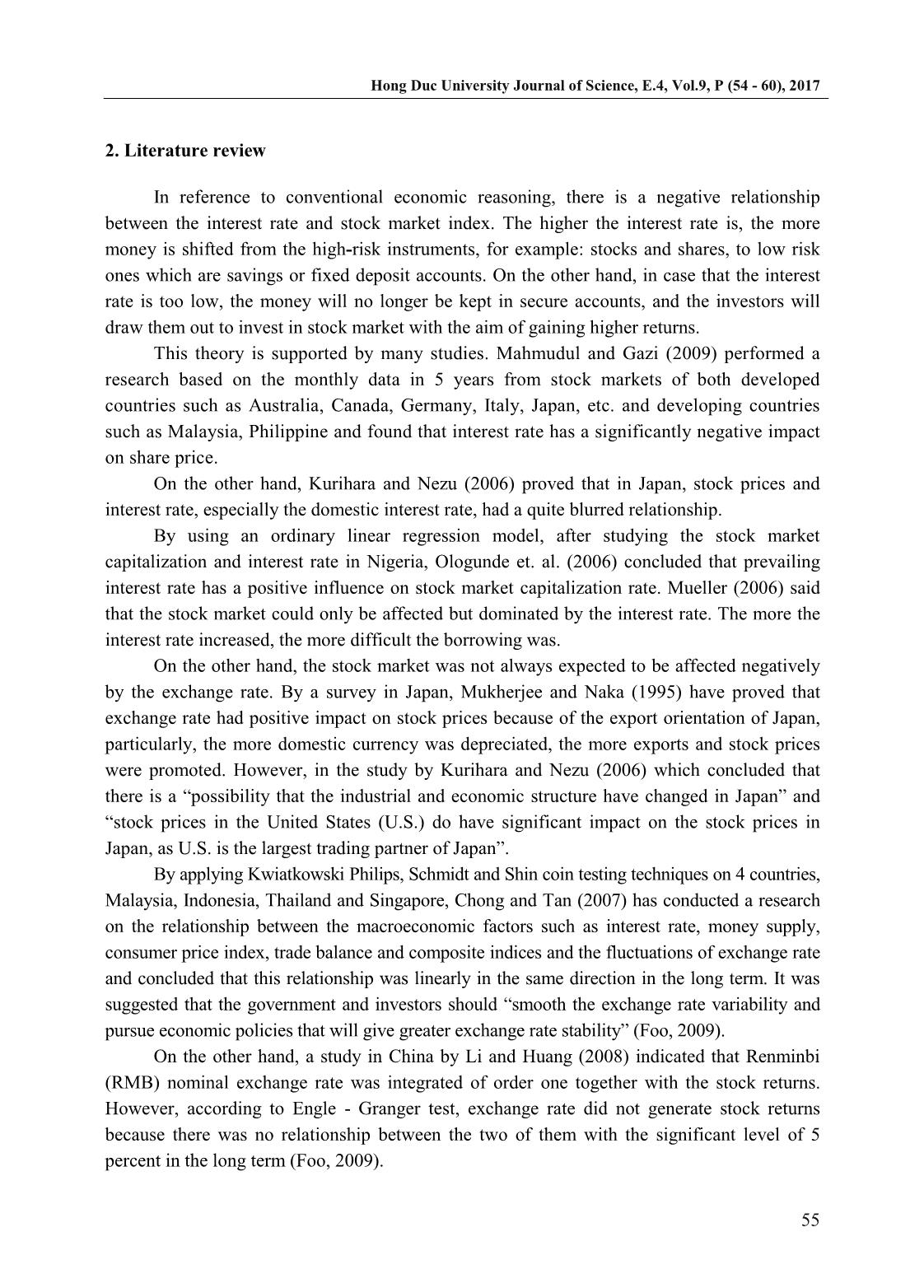
Trang 2
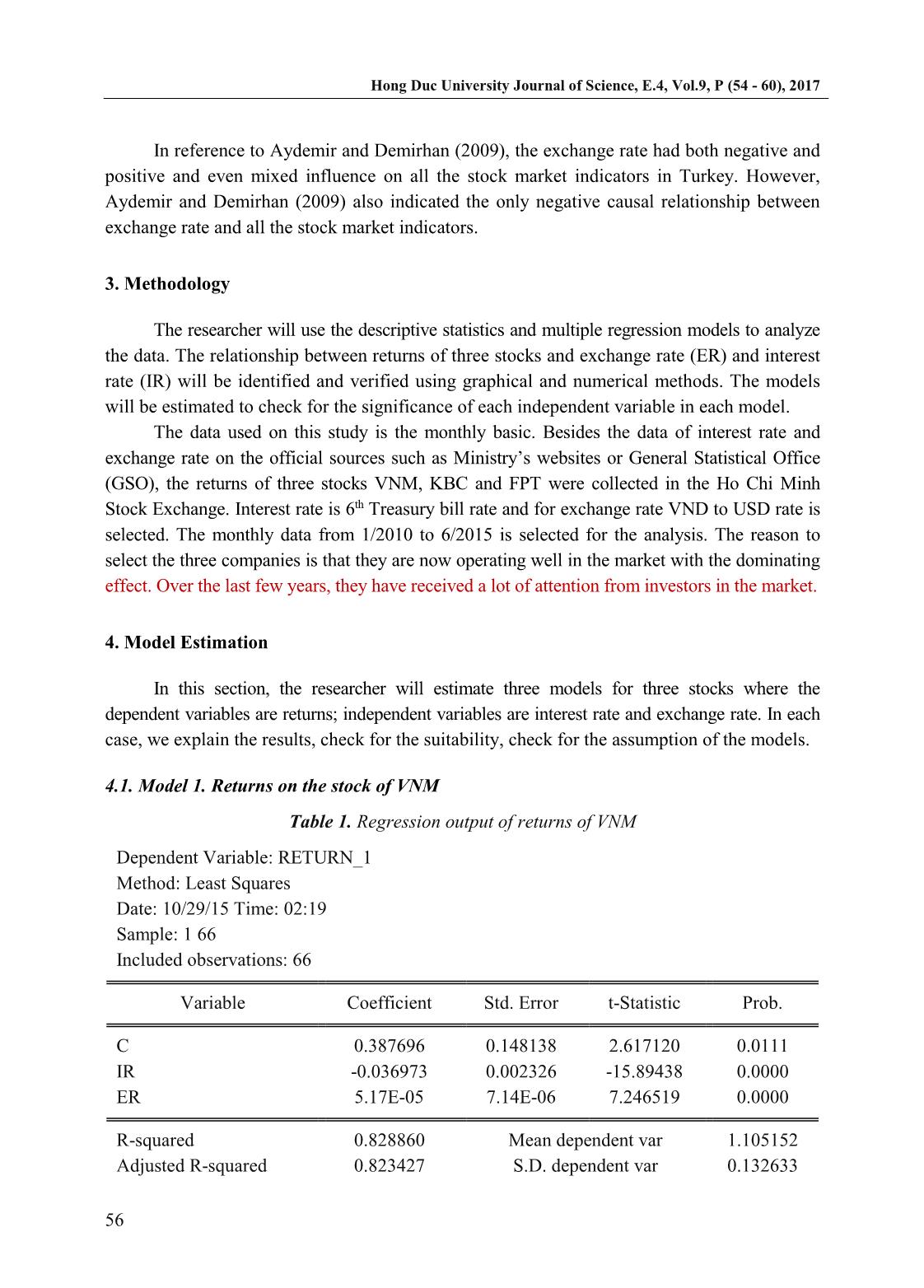
Trang 3
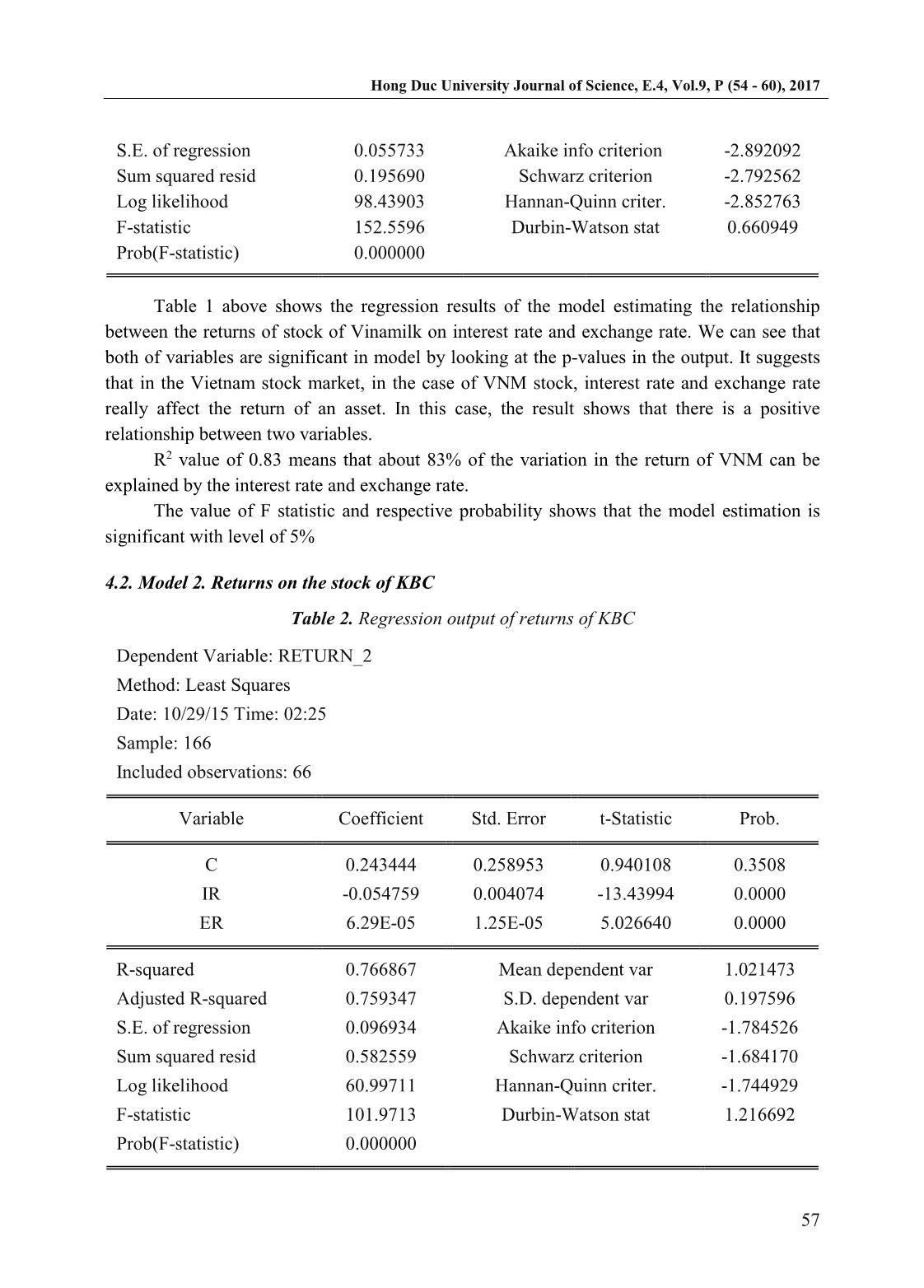
Trang 4
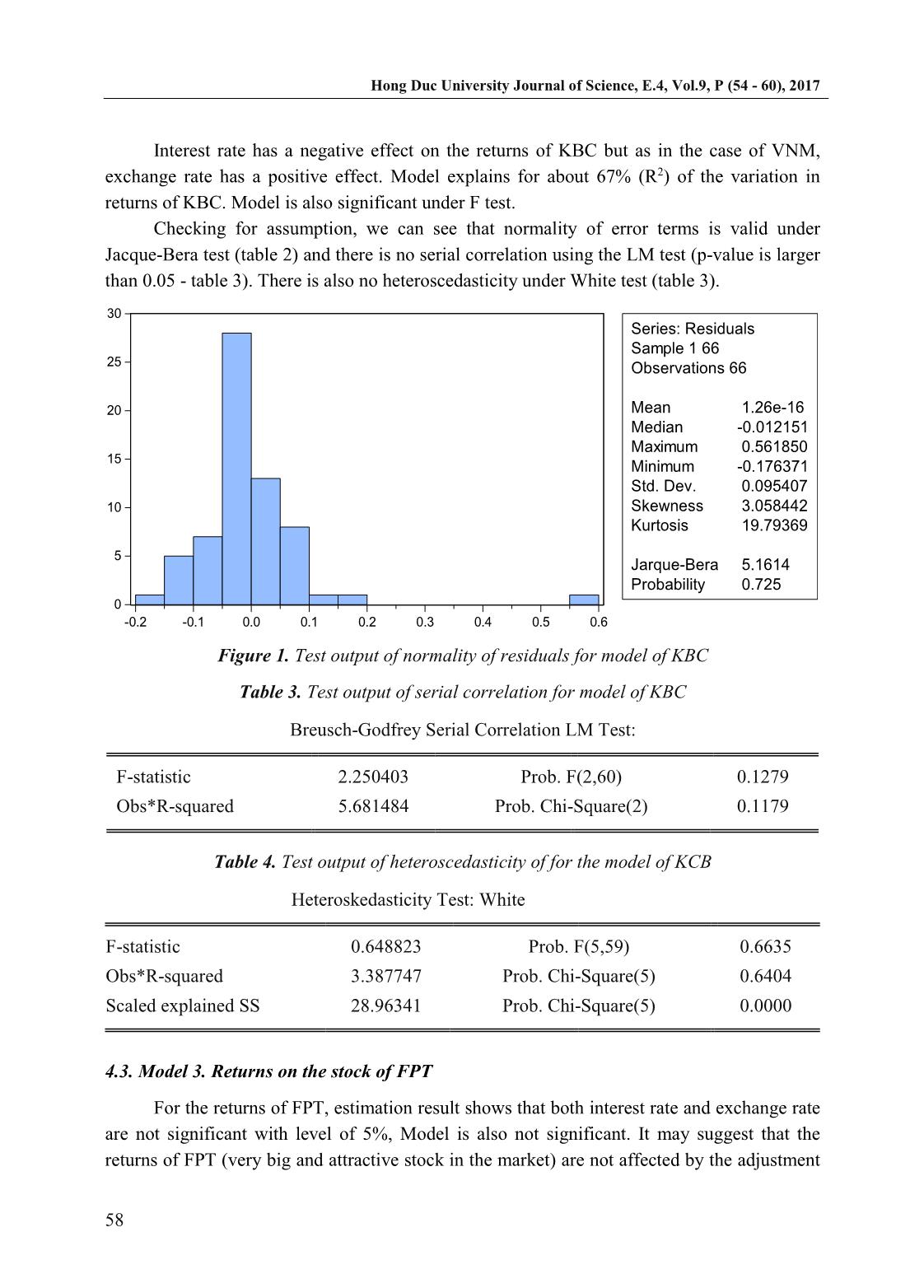
Trang 5
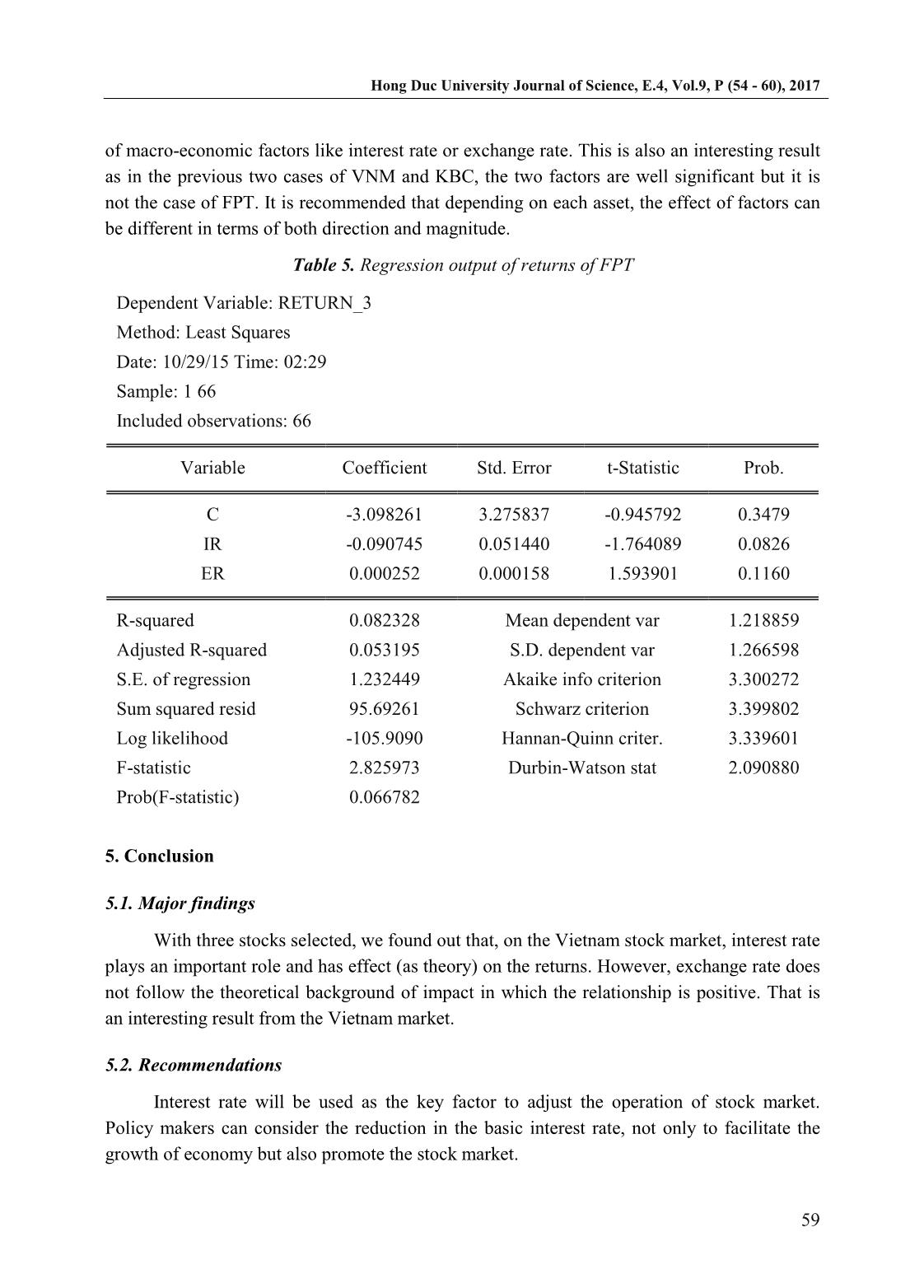
Trang 6

Trang 7
Bạn đang xem tài liệu "Analysis of the impact of exchange rate and interest rate on stock return in vietnam stock market", để tải tài liệu gốc về máy hãy click vào nút Download ở trên
Tóm tắt nội dung tài liệu: Analysis of the impact of exchange rate and interest rate on stock return in vietnam stock market
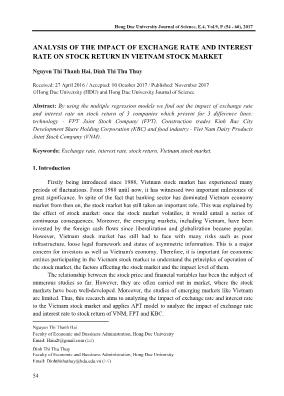
Hong Duc University Journal of Science, E.4, Vol.9, P (54 - 60), 2017 54 ANALYSIS OF THE IMPACT OF EXCHANGE RATE AND INTEREST RATE ON STOCK RETURN IN VIETNAM STOCK MARKET Nguyen Thi Thanh Hai, Dinh Thi Thu Thuy1 Received: 27 April 2016 / Accepted: 10 October 2017 / Published: November 2017 ©Hong Duc University (HDU) and Hong Duc University Journal of Science Abstract: By using the multiple regression models we find out the impact of exchange rate and interest rate on stock return of 3 companies which present for 3 difference lines: technology - FPT Joint Stock Company (FPT), Construction trades Kinh Bac City Development Share Holding Corporation (KBC) and food industry - Viet Nam Dairy Products Joint Stock Company (VNM). Keywords: Exchange rate, interest rate, stock return, Vietnam stock market. 1. Introduction Firstly being introduced since 1988, Vietnam stock market has experienced many periods of fluctuations. From 1988 until now, it has witnessed two important milestones of great significance. In spite of the fact that banking sector has dominated Vietnam economy market from then on, the stock market has still taken an important role. This was explained by the effect of stock market: once the stock market volatiles, it would entail a series of continuous consequences. Moreover, the emerging markets, including Vietnam, have been invested by the foreign cash flows since liberalization and globalization became popular. However, Vietnam stock market has still had to face with many risks such as poor infrastructure, loose legal framework and status of asymmetric information. This is a major concern for investors as well as Vietnam's economy. Therefore, it is important for economic entities participating in the Vietnam stock market to understand the principles of operation of the stock market, the factors affecting the stock market and the impact level of them. The relationship between the stock price and financial variables has been the subject of numerous studies so far. However, they are often carried out in market, where the stock markets have been well-developed. Moreover, the studies of emerging markets like Vietnam are limited. Thus, this research aims to analyzing the impact of exchange rate and interest rate to the Vietnam stock market and applies APT model to analyze the impact of exchange rate and interest rate to stock return of VNM, FPT and KBC. Nguyen Thi Thanh Hai Faculty of Economic and Bussiness Administration, Hong Duc University Email: Hain2t@gmail.com ( ) Dinh Thi Thu Thuy Faculty of Economic and Bussiness Administration, Hong Duc University Email: Dinhthithuthuy@hdu.edu.vn ( ) Hong Duc University Journal of Science, E.4, Vol.9, P (54 - 60), 2017 55 2. Literature review In reference to conventional economic reasoning, there is a negative relationship between the interest rate and stock market index. The higher the interest rate is, the more money is shifted from the high-risk instruments, for example: stocks and shares, to low risk ones which are savings or fixed deposit accounts. On the other hand, in case that the interest rate is too low, the money will no longer be kept in secure accounts, and the investors will draw them out to invest in stock market with the aim of gaining higher returns. This theory is supported by many studies. Mahmudul and Gazi (2009) performed a research based on the monthly data in 5 years from stock markets of both developed countries such as Australia, Canada, Germany, Italy, Japan, etc. and developing countries such as Malaysia, Philippine and found that interest rate has a significantly negative impact on share price. On the other hand, Kurihara and Nezu (2006) proved that in Japan, stock prices and interest rate, especially the domestic interest rate, had a quite blurred relationship. By using an ordinary linear regression model, after studying the stock market capitalization and interest rate in Nigeria, Ologunde et. al. (2006) concluded that prevailing interest rate has a positive influence on stock market capitalization rate. Mueller (2006) said that the stock market could only be affected but dominated by the interest rate. The more the interest rate increased, the more difficult the borrowing was. On the other hand, the stock market was not always expected to be affected negatively by the exchange rate. By a survey in Japan, Mukherjee and Naka (1995) have proved that exchange rate had positive impact on stock prices because of the export orientation of Japan, particularly, the more domestic currency was depreciated, the more exports and stock prices were promoted. However, in the study by Kurihara and Nezu (2006) which concluded that there is a “possibility that the industrial and economic structure have changed in Japan” and “stock prices in the United States (U.S.) do have significant impact on the stock prices in Japan, as U.S. is the largest trading partner of Japan”. By applying Kwiatkowski Philips, Schmidt and Shin coin testing techniques on 4 countries, Malaysia, Indonesia, Thailand and Singapore, Chong and Tan (2007) has conducted a research on the relationship between the macroeconomic factors such as interest rate, money supply, consumer price index, trade balance and composite indices and the fluctuations of exchange rate and concluded that this relationship was linearly in the same direction in the long term. It was suggested that the government and investors should “smooth the exchange rate variability and pursue economic policies that will give greater exchange rate stability” (Foo, 2009). On the other hand, a study in China by Li and Huang (2008) indicated that Renminbi (RMB) nominal exchange rate was integrated of order one together with the stock returns. However, according to Engle - Granger test, exchange rate did not generate stock returns because there was no relationship between the two of them with the significant level of 5 percent in the long term (Foo, 2009). Hong Duc University Journal of Science, E.4, Vol.9, P (54 - 60), 2017 56 In reference to Aydemir and Demirhan (2009), the exchange rate had both negative and positive and even mixed influence on all the stock market indicators in Turkey. However, Aydemir and Demirhan (2009) also indicated the only negative causal relationship between exchange rate and all the stock market indicators. 3. Methodology The researcher will use the descriptive statistics and multiple regression models to analyze the data. The relationship between returns of three stocks and exchange rate (ER) and interest rate (IR) will be identified and verified using graphical and numerical methods. The models will be estimated to check for the significance of each independent variable in each model. The data used on this study is the monthly basic. Besides the data of interest rate and exchange rate on the official sources such as Ministry’s websites or General Statistical Office (GSO), the returns of three stocks VNM, KBC and FPT were collected in the Ho Chi Minh Stock Exchange. Interest rate is 6th Treasury bill rate and for exchange rate VND to USD rate is selected. The monthly data from 1/2010 to 6/2015 is selected for the analysis. The reason to select the three companies is that they are now operating well in the market with the dominating effect. Over the last few years, they have received a lot of attention from investors in the market. 4. Model Estimation In this section, the researcher will estimate three models for three stocks where the dependent variables are returns; independent variables are interest rate and exchange rate. In each case, we explain the results, check for the suitability, check for the assumption of the models. 4.1. Model 1. Returns on the stock of VNM Table 1. Regression output of returns of VNM Dependent Variable: RETURN_1 Method: Least Squares Date: 10/29/15 Time: 02:19 Sample: 1 66 Included observations: 66 Variable Coefficient Std. Error t-Statistic Prob. C 0.387696 0.148138 2.617120 0.0111 IR -0.036973 0.002326 -15.89438 0.0000 ER 5.17E-05 7.14E-06 7.246519 0.0000 R-squared 0.828860 Mean dependent var 1.105152 Adjusted R-squared 0.823427 S.D. dependent var 0.132633 Hong Duc University Journal of Science, E.4, Vol.9, P (54 - 60), 2017 57 S.E. of regression 0.055733 Akaike info criterion -2.892092 Sum squared resid 0.195690 Schwarz criterion -2.792562 Log likelihood 98.43903 Hannan-Quinn criter. -2.852763 F-statistic 152.5596 Durbin-Watson stat 0.660949 Prob(F-statistic) 0.000000 Table 1 above shows the regression results of the model estimating the relationship between the returns of stock of Vinamilk on interest rate and exchange rate. We can see that both of variables are significant in model by looking at the p-values in the output. It suggests that in the Vietnam stock market, in the case of VNM stock, interest rate and exchange rate really affect the return of an asset. In this case, the result shows that there is a positive relationship between two variables. R2 value of 0.83 means that about 83% of the variation in the return of VNM can be explained by the interest rate and exchange rate. The value of F statistic and respective probability shows that the model estimation is significant with level of 5% 4.2. Model 2. Returns on the stock of KBC Table 2. Regression output of returns of KBC Dependent Variable: RETURN_2 Method: Least Squares Date: 10/29/15 Time: 02:25 Sample: 166 Included observations: 66 Variable Coefficient Std. Error t-Statistic Prob. C 0.243444 0.258953 0.940108 0.3508 IR -0.054759 0.004074 -13.43994 0.0000 ER 6.29E-05 1.25E-05 5.026640 0.0000 R-squared 0.766867 Mean dependent var 1.021473 Adjusted R-squared 0.759347 S.D. dependent var 0.197596 S.E. of regression 0.096934 Akaike info criterion -1.784526 Sum squared resid 0.582559 Schwarz criterion -1.684170 Log likelihood 60.99711 Hannan-Quinn criter. -1.744929 F-statistic 101.9713 Durbin-Watson stat 1.216692 Prob(F-statistic) 0.000000 Hong Duc University Journal of Science, E.4, Vol.9, P (54 - 60), 2017 58 Interest rate has a negative effect on the returns of KBC but as in the case of VNM, exchange rate has a positive effect. Model explains for about 67% (R2) of the variation in returns of KBC. Model is also significant under F test. Checking for assumption, we can see that normality of error terms is valid under Jacque-Bera test (table 2) and there is no serial correlation using the LM test (p-value is larger than 0.05 - table 3). There is also no heteroscedasticity under White test (table 3). 0 5 10 15 20 25 30 -0.2 -0.1 0.0 0.1 0.2 0.3 0.4 0.5 0.6 Series: Residuals Sample 1 66 Observations 66 Mean 1.26e-16 Median -0.012151 Maximum 0.561850 Minimum -0.176371 Std. Dev. 0.095407 Skewness 3.058442 Kurtosis 19.79369 Jarque-Bera 5.1614 Probability 0.725 Figure 1. Test output of normality of residuals for model of KBC Table 3. Test output of serial correlation for model of KBC Breusch-Godfrey Serial Correlation LM Test: F-statistic 2.250403 Prob. F(2,60) 0.1279 Obs*R-squared 5.681484 Prob. Chi-Square(2) 0.1179 Table 4. Test output of heteroscedasticity of for the model of KCB Heteroskedasticity Test: White F-statistic 0.648823 Prob. F(5,59) 0.6635 Obs*R-squared 3.387747 Prob. Chi-Square(5) 0.6404 Scaled explained SS 28.96341 Prob. Chi-Square(5) 0.0000 4.3. Model 3. Returns on the stock of FPT For the returns of FPT, estimation result shows that both interest rate and exchange rate are not significant with level of 5%, Model is also not significant. It may suggest that the returns of FPT (very big and attractive stock in the market) are not affected by the adjustment Hong Duc University Journal of Science, E.4, Vol.9, P (54 - 60), 2017 59 of macro-economic factors like interest rate or exchange rate. This is also an interesting result as in the previous two cases of VNM and KBC, the two factors are well significant but it is not the case of FPT. It is recommended that depending on each asset, the effect of factors can be different in terms of both direction and magnitude. Table 5. Regression output of returns of FPT Dependent Variable: RETURN_3 Method: Least Squares Date: 10/29/15 Time: 02:29 Sample: 1 66 Included observations: 66 Variable Coefficient Std. Error t-Statistic Prob. C -3.098261 3.275837 -0.945792 0.3479 IR -0.090745 0.051440 -1.764089 0.0826 ER 0.000252 0.000158 1.593901 0.1160 R-squared 0.082328 Mean dependent var 1.218859 Adjusted R-squared 0.053195 S.D. dependent var 1.266598 S.E. of regression 1.232449 Akaike info criterion 3.300272 Sum squared resid 95.69261 Schwarz criterion 3.399802 Log likelihood -105.9090 Hannan-Quinn criter. 3.339601 F-statistic 2.825973 Durbin-Watson stat 2.090880 Prob(F-statistic) 0.066782 5. Conclusion 5.1. Major findings With three stocks selected, we found out that, on the Vietnam stock market, interest rate plays an important role and has effect (as theory) on the returns. However, exchange rate does not follow the theoretical background of impact in which the relationship is positive. That is an interesting result from the Vietnam market. 5.2. Recommendations Interest rate will be used as the key factor to adjust the operation of stock market. Policy makers can consider the reduction in the basic interest rate, not only to facilitate the growth of economy but also promote the stock market. Hong Duc University Journal of Science, E.4, Vol.9, P (54 - 60), 2017 60 To use the exchange rate as the tool for management, it should be carefully considered as the effect of exchange rate adjustment is sometimes not clear to the economy in general and on the stock market in particular. The adjustment of exchange rate should be placed in the context of many changing factors in the economy that make the impact of summarized factors could be clear and measured. References [1] Mahmudul, A., Gazi Salah, U., (2009), The relationship between interest rate and stock price: Empirical evidence from developed and developing countries, International journal of business and management, 4(3): pp. 43-51. Available from: [Accessed: 02/6/2015] [2] Mukherjee, T. K. &Naka, A. (1995), Dynamic relations between macroeconomic variables and the Japanese stock market: an application of a vector error correction model, The Journal of Financial Research, 18(2): pp. 223-237. Available from: [Accessed: 22/6/2015]. [3] Liow, K. H., Huang, Q. (2004), Interest Rate Risk and Time-Varying Excess Returns for Property Stocks: An Asset Pricing Perspective, Working Paper. emeraldinsight.com/doi/abs/10.1108/14635780610659919.Accessed: 02/4/2015. [4] Kurihara, Y., and Nezu, E., (2006), Recent Stock Price Relationships between Japanese and US Stock Markets, Studies in Economics and Finance, 23(3): 211-226. Available from: [5] Ologunde, A., Elumilade, D., Saolu, T., (2006), Stock market capitalization and interest rate in Nigeria: A time series analysis, International Research Journal of Finance and Economics, 1(4): 154-67. Available from: view/39274. [6] Mueller G.R. (2006), Real Estate Space Market Cycles. Testimony before the Subcommittee on Financial Institutions and Consumer Credit of the Committee on Financial Services. United States House of Representatives, September 14. Available from: https://www.fdic.gov/regulations/laws/federal/2007/07c04test1ag.pdf
File đính kèm:
 analysis_of_the_impact_of_exchange_rate_and_interest_rate_on.pdf
analysis_of_the_impact_of_exchange_rate_and_interest_rate_on.pdf

